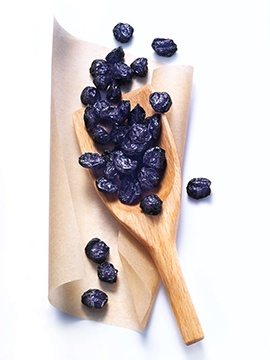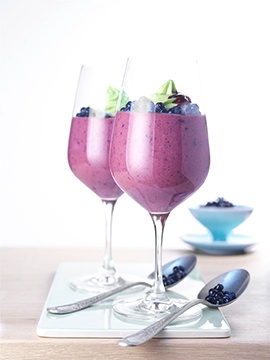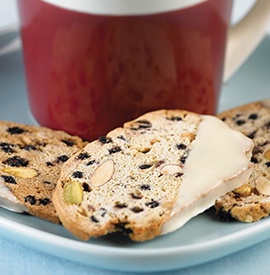Dried Wild Blueberries Add Dazzle (and Taste) in All Kinds of Places
Editorial consulting by the Culinary Institute of America
In case you haven’t noticed, dried fruit is experiencing a comeback. Remember the days when Trader Joe’s was one of the few places in America that truly celebrated the dried fruit, and manufacturers used them only once a year in Christmas fruit cake?
Today dried fruit is showing up in all sorts of places: from traditional baked goods, snack bars, granola, trail mix, and oatmeal to jerky, chutneys, salads, and wilted greens. Not to mention cheese, yogurt, ice cream, and even pet food.

Panera Bread was an early innovator with the dried Wild Blueberry, and it paid off. Their Wild Blue Scone is a leading bakery item for Panera and their head baker, Tom Gumpel, says they can’t take it off the menu because customers would protest.
Why are dried Wild Blueberries so special?
The chewy, flavor-filled punch that comes from those tiny sweet/tart berries makes a memorable taste and texture sensation. With their potent flavor, deep purple hue, and tiny size, dried Wild Blueberries are like little flavor bombs that can elevate any food.
Because of increasing demand, Wild Blueberries are now available in a variety of interesting formats: The moisture content can vary from moist to dry to almost crumbly; the texture can vary from crunchy to chewy; and they are available whole or in pieces. How about vacuum microwave dried, infused, freeze dried? Dried Wild Blueberries are a simple, Plus-1addition to a signature menu item or manufactured food. In other words, with a single ingredient you can transform food to innovative, premium status.
[blog_cta post_id=”16169″]
No matter what format you need, you’ll get the great taste and nutritional payoff that comes with all Wild Blueberries.
Wild Blueberries lend themselves beautifully to dehydration. They have a naturally lower water content than cultivated blueberries, which makes them perfect candidates for fast dehydration with minimal nutrient and flavor loss. The flavor actually intensifies as moisture is removed. This in turn preserves all the antioxidants and flavors, which make them so good when they’re fresh. Despite growing in the wild, the crop is managed to produce large quantities at reasonable prices.
How do food innovators creatively leverage growing customer demand for natural ingredients like Wild Blueberries?
To create new flavors and textures, many chefs and bakers are turning to dried Wild Blueberries. Some are even experimenting with new formats. Have you thought about reconstituting dried Wild Blueberries with flavorful liquids? Flavored syrups, fruit juices, and liqueurs all offer chefs and bakers different options to add interesting flavors to this natural ingredient. The options are of course endless; vinegars, rose water, and extracts – basically any water-based liquid you can think of. Depending on the liquid, you can adjust sweetness or acidity while also imparting new flavors into the Wild Blueberries.

Beyond flavor, chefs have some control over the texture of the dried berries as well. Fully hydrated Wild Blueberries can easily be pureed and added to smoothies, frostings, or cocktails with an intense and distinctive flavor. Slight hydration provides a chewy texture that’s perfect for folding into cake, muffin or bread batters, garnishing healthy salads, or adding flavor to a house-made granola. Freeze-dried Wild Blueberries offer an incredible crispness with less intense sweetness and acidity. They can add welcome texture to earthy venison tartare, improve upon a fall or winter salad, and create a perfect ice cream sundae topping.
[blog_cta post_id=”16167″]
Of course, there are many options for chefs and bakers to utilize whole, natural food products and ingredients. But working with dried Wild Blueberries doesn’t require much of the headache often associated with maintaining and constantly updating a seasonally specific menu (let alone a micro-seasonal menu). They’re simple to source, shelf stable and they provide a natural, wholesome, nutritious, and tasty impact on your menu.

About the Author
Zach Minot

Writer & Recipe Developer, The Culinary Institute of America
Zach Minot is a writer and recipe developer for The Culinary Institute of America and other clients. He grew up along the east coast, living in Florida, Maine, New Jersey, Connecticut, and New York before finally arriving in Vermont for good in 2010. Zach has cooked for numerous high-end restaurants including New York City’s Gramercy Tavern, and Vermont’s The Kitchen Table Bistro and the Inn at Shelburne Farms. He has worked on the set of acclaimed Food Network’s Good Eats with Alton Brown and has been hands-on with culinary media since 2005.

